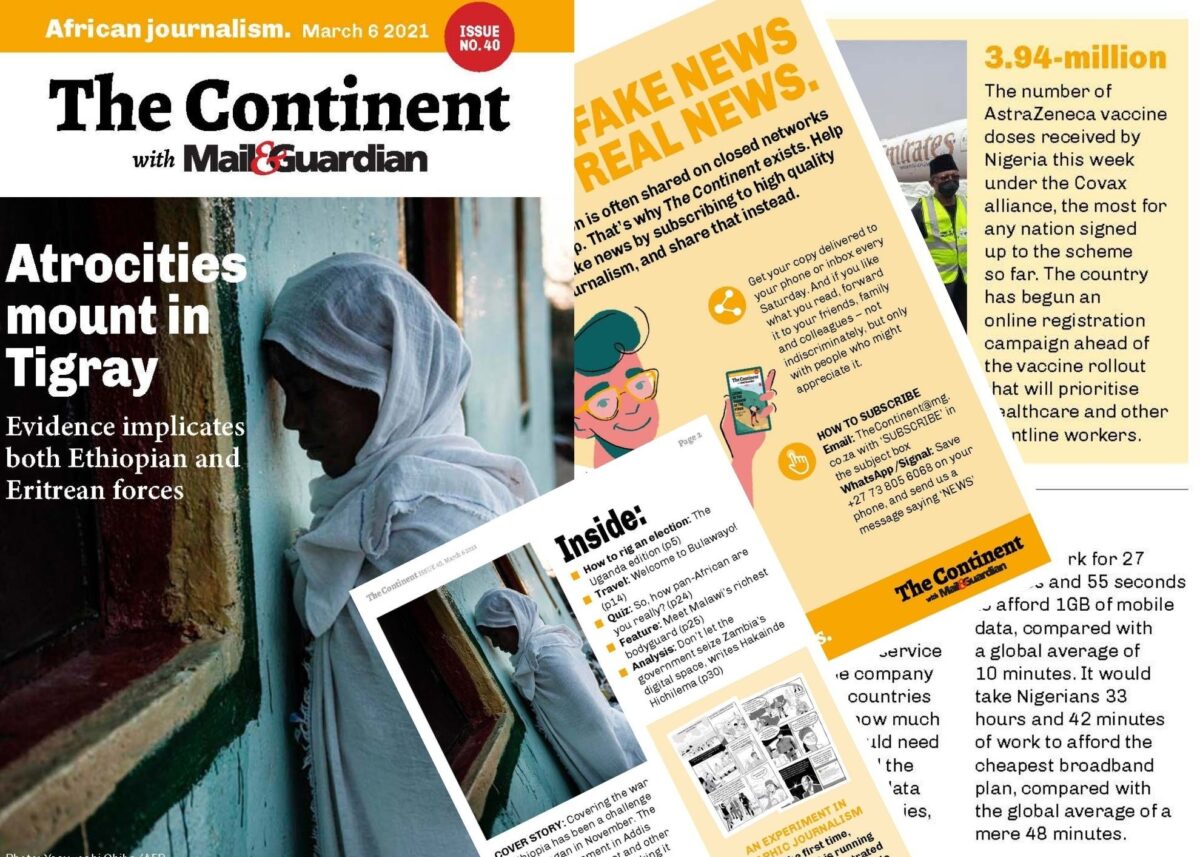It’s April of 2020 in Johannesburg, South Africa. The usual bustling streets of the country’s urban jungle are silent as a result of the COVID-19 lockdown, but somewhere quietly a group of journalists are working away to reinvent the classic weekly newspaper for a pan-African audience…on WhatsApp.
Simon Allison, Africa editor at one of the country’s leading print newspapers, The Mail & Guardian, along with a team of contributors, launched The Continent in the midst of the global pandemic. “In terms of international and continental stories, those are so often written for a Western audience, and as Africans we are used to going to [Western news sites] to read about Africa. Those stories are not written for us, so we have tried to flip that script,” he says.
The Continent is a digital, weekly newspaper that’s delivered to subscribers via WhatsApp, Signal, or email. After launching in April, the ‘paper’ was met with success, but soon the amount of news coming in was too much, and with little funding left to pay contributors, Allison and his team needed additional support.

The Continent pays their contributors per story. “The per word thing has never made sense to me. Seems to be an [incentive] to pad and inflate stories, which defeats the point of what we are trying to do,” says Allison.
“We were trying to produce a continent-wide picture of what was going on with the pandemic; both the health and broader economic and political consequences. We found that we had a lot of journalists wanting to work with us, a lot of demand for the journalism we were producing, and we needed some funding to ensure we could pay for the journalism that was happening and that’s where the Internews grant came in,” says Allison.
With the Internews Information Saves Lives Rapid Response Fund, The Continent was able to continue producing their digital weekly newspaper specifically designed for a growing pan-African audience. Allison describes The Continent as a print newspaper in a digital space. “We are trying to replicate the experience of reading an actual newspaper and the reason this is important is because I think that people engage with physical newspapers differently than they do to websites,” he says.
Why WhatsApp or Signal versus subscribing to an email newsletter or digital copy?
This was a no brainer, says Allison. “WhatsApp is by far the dominant social media platform in Africa. It is also the primary platform on which fake news spreads. WhatsApp is a huge social media platform globally, but news has not figured out a way to crack it.”
The Continent is delivered in the form of a PDF file, along with a short teaser paragraph about what the edition covers. The PDF can be immediately downloaded and opened on the phone and without leaving WhatsApp (or Signal) and without clicking on any additional links. “One of the other factors which is quite big, is that in many African countries your cell phone data plan might include free WhatsApp data, so you can use as much WhatsApp as you like but as soon as you go onto a website you now have to pay for that data. We’re taking advantage of that,” says Allison.
Is The Continent a rare success story, or the future of newspapers?
“I honestly believe that this is the future of newspapers, because that’s essentially what it is, is a recreation of a newspaper on a digital platform,” says Allison. “Why would you keep incurring the costs of production and distribution of physical newspapers if you can recreate that reading experience in a digital format.”
The Continent was inspired by a Zimbabwean publication called 263Chat, who Allison says pioneered the idea of a WhatsApp newspaper in Africa.
Currently, The Continent has between 60 and 70 thousand readers, but monitoring analytics from WhatsApp and Signal is not easy. They know who receives the paper, but gauging the reach is tricky.
“We ask our subscribers if they feel comfortable to please share The Continent, not indiscriminately, but only with people who may appreciate it. We are only ever going to reach a certain number of people directly, but the idea is we can send it to someone and they can send it to their WhatsApp groups and their colleagues and friends.”
Simon Alison, editor: The Continent
According to reader surveys, Allison says that roughly 20 to 25 percent of respondents reported sharing The Continent with five or six other individuals, or WhatsApp groups.
“Suddenly you’re taking advantage of this exponential sharing effect, which is what makes fake news so powerful. The idea of course is to replace fake news with the real news,” he says.
Top 3 tips for taking your news to WhatsApp:
- Design: The design needs to be readable and should follow a traditional newspaper style.
- High-level editing skills: The editing process is ruthless, says Allison. “What I have learnt in doing that is that almost no story deserves to be 900 words, actually.” If you as the editor are taking that 900 word story and making it into 270 words, you have done that so the reader has a really easy reading experience. The news becomes more accessible, interesting and takes up much less of the reader’s time.”
- Distribution: Less is more. The impact of a small group of committed subscribers sharing amongst their social circles will be larger than a huge number of not committed subscribers, says Allison.